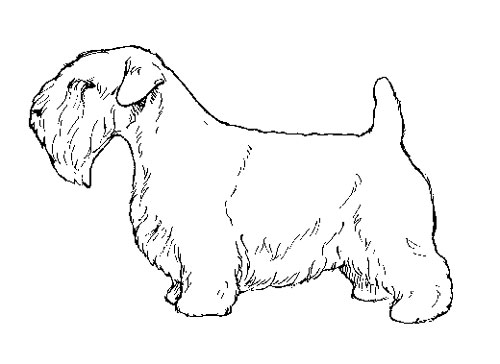Sealyham Terrier
Terrier Group
The goals and purposes of this breed standard include: to furnish guidelines for breeders who wish to maintain the quality of their breed and to improve it; to advance this breed to a state of similarity throughout the world; and to act as a guide for judges.
Breeders and judges have the responsibility to avoid any conditions or exaggerations that are detrimental to the health, welfare, essence and soundness of this breed, and must take the responsibility to see that these are not perpetuated.
Any departure from the following should be considered a fault, and the seriousness with which the fault should be regarded should be in exact proportion to its degree and its effect upon the health and welfare of the dog and on the dog’s ability to perform its traditional work.
History
The Sealyham Terrier was developed in the mid 19th century by Captain John Edwardes in the Haverfordwest region of South Wales. He wanted the ideal working terrier to dig out badgers and fox and to accompany his Otterhounds on the hunt. The breed is named after his family estate.
The Sealyham Terrier was recognized by the United Kennel Club in 1919.
General Appearance
The Sealyham Terrier is a strong, sturdily built, active working Terrier that is oblong in general outline. It has as much substance as possible for a dog that is quick and capable of digging and battling its quarry underground.
Characteristics
Keen and alert, the Sealyham Terrier is fearless but has a friendly nature.
Head
Long, broad and powerful, the head is in perfect balance with the body. There is a moderate stop.
SKULL
Very slightly domed with good width between the ears.
MUZZLE
Long and powerful, with flat cheeks and square jaws.
TEETH
A full complement of strong, white teeth meet in a level or scissors bite, with the canines fitting closely together.
Serious Faults: Overshot or undershot bites.
EYES
Medium size, round in shape, set fairly deeply. Very dark in color. Dark pigment of the eye rims is preferred, but lack of pigment is acceptable.
NOSE
Fully pigmented, black in color.
EARS
The ears are well rounded at the tip and long enough to reach the outer corner of the eye. They are folded level with the top of the head, the forward edge being close to the cheek. The ear leather is thin but of sufficient thickness to avoid vertical creases.
Serious Faults: Prick, tulip, rose or hound ears.
Neck
Long, thick and muscular, clean at the throat. Blends neatly into well-laid shoulders.
Forequarters
The well laid back, powerful shoulders are sufficiently wide to permit freedom of action, but are not over muscled.
Serious Faults: Upright or straight shoulder placement.
FORELEGS
The strong, well boned forelegs are as straight as is consistent with a well let down chest. Elbows lie close to the chest.
Body
The body is medium length and flexible. The back is level. Chest is deep between the front legs and the ribs are well sprung.
Hindquarters
The very powerful hindquarters protrude well past the set-on of the tail.
HIND LEGS
Thighs are deep and muscular. Stifle and hock joints are well bent. Rear pasterns are parallel to one another.
Feet
Round and cat-like, with thick pads. Toes point straight ahead.
Tail
Set straight off the back and carried upright. Thick with a rounded tip. Customarily docked to a medium length. If natural, the tail should be straight and carried upright, not too far forward over the back.
Coat
The breed has a weather-resistant double coat. The outer coat is hard and wiry; the undercoat is soft and dense.
Serious Faults: Silky or curly coats.
Color
All white, or predominately white with lemon, brown, blue or badger markings on the head and/or ears.
Serious Faults: Heavy black markings. Ticking on the body.
Height & Weight
Height should not exceed 12 inches at the shoulder.
Ideal weight is approximately 20 pounds for males, 18 pounds for females, but general conformation and type are more important than weight.
Gait
Movement is sound, strong, quick, free, true and level. Serious Fault: Lack of drive.
Disqualifications
(A dog with a Disqualification must not be considered for placement in a conformation event, and must be reported to UKC.)
Unilateral or bilateral cryptorchid.
Viciousness or extreme shyness.
Albinism.
The docking of tails and cropping of ears in America is legal and remains a personal choice. However, as an international registry, the United Kennel Club is aware that the practices of cropping and docking have been forbidden in some countries. In light of these developments, the United Kennel Club feels that no dog in any UKC event, including conformation, shall be penalized for a full tail or natural ears.

Looking for a Dog?
Find a dog that will fit your family.
Note: The breeders on this list are not endorsed by UKC.
Revised April 15, 2007
©Copyright 1992, United Kennel Club
